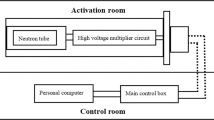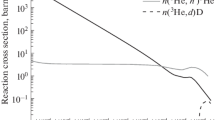Abstract
Neutron skyshine doses were calculated using a Monte Carlo code, FLUKA, by changing the heights and openings of shield walls. In the calculation geometry, the distance from the floor of the room to the roof was varied from 3 to 10 m. The target into which electrons were injected was located at a height of 2.3 m. The distance between the shield wall and target was varied from 1.5 to 5.79 m. Further, the height of the atmosphere was varied from 10 to 40 m. Consequently, the dose outside the shield wall increased with the height of the atmosphere and became saturated at 30 m; the neutrons reaching the ground were observed to be scattered mostly below 30 m. For neutron skyshine, NCRP Report No. 51 provided an expression stating that the neutron dose at ground level was proportional to the solid angle of shield walls and inversely proportional to the square of the distance from the target to the ceiling plus 2 m. In the Monte Carlo results, the doses conformed to the expression below a height of 5 m and above a distance of 2.6 m from the target to the shield wall. Under other conditions, the doses became higher than those predicted by the expression, which indicated the large contribution of neutrons emitted immediately above the target to the skyshine doses.
Access provided by Autonomous University of Puebla. Download conference paper PDF
Similar content being viewed by others
Keywords
1 Introduction
Skyshine is a phenomenon wherein radiation scattered by the atmosphere above a ceiling reaches the ground level outside the shield. The radiation is crucial when the ceiling is thin. Previously, simple equations for accelerator facilities have been proposed [1]; however, their consistency with experimental data was not satisfactory [2]. With an increase in the accelerating energy, the contribution of neutrons to the skyshine dose increases. The neutron doses from an 18 MeV accelerator are higher than photon doses for skyshine [2]. In the equation for neutron skyshine, the dose is proportional to the solid angle of shield walls and inversely proportional to the square of the distance from the target to the ceiling plus 2 m. By using a Monte Carlo code, the doses can be obtained with variation of these parameters. In this study, neutron skyshine doses were calculated using a Monte Carlo code by changing the ceiling heights and openings of shield walls.
2 Calculation Method
2.1 A Monte Carlo Method
Figure 1 shows the vertical section view of the Monte Carlo calculation model. An electron of 18 MeV was impinged on the lead cylindrical target horizontally. The target was surrounded by a cylindrical shield. No roof shield was assumed.
A Monte Carlo transport code FLUKA (Ver. 2011.2c.6) [3] was used with the flair interface (Ver. 2.3-0) for the calculations. A multicore CPU was used by applying different random number seeds on each one-day run. In the calculation geometry of Fig. 1, the distance from the floor of the room to the top of the shield was varied from 3 m to 10 m. The cylindrical target of radius 3.3 cm was located at a height of 2.3 m from the ground. A large dependence of neutron doses on the target size was not observed compared with photon doses [4]. The distance between the cylindrical shield wall and target was varied from 1.5 to 9.5 m. Further, the height of the atmosphere was varied from 10 to 40 m. As the shield and ground were assigned as “black hole” in the input, all the particles impinging on the materials were absorbed immediately.
2.2 An Equation for Neutron Skyshine
NCRP Report No. 51 [1] provided the equation for neutron skyshine as follows:
where H is the neutron dose equivalent rate, Bns is the roof shielding transmission ratio for neutrons, Φ O is the neutron fluence rate at 1 m from the target, Ω is the solid angle of the shield walls, and di is the distance from the target to ceiling plus 2 m.
3 Monte Carlo Calculation Results
3.1 Atmosphere Height
Figure 2 shows the calculated neutron dose equivalent distribution with respect to the distance from the target. In the Monte Carlo calculation model, the shield was located in the range of 3.86 to 4.36 m from the target, and the height of the shield was 4.97 m. The top height of atmosphere was 20 m. Inside the shield wall, the doses steeply decreased with the distance from the target. Outside the wall, the doses, which were due to the skyshine, were approximately constant up to 20 m. The average values in the flat region are plotted in Figs. 3, 4, 5, and their errors were approximately 100% as shown in Fig. 2.
Neutron dose equivalent per incident electron calculated using the Monte Carlo code for the model of Fig. 1 as a function of the distance from the target. The doses at the points more than 4.36 m from the target, which are almost constant, are only due to the skyshine. The location of the shield was 386 cm
Neutron skyshine dose equivalent normalized at the distance from the target of 30 m with variation of the height of the air region, i.e., the dotted rectangle area of Fig. 1
Figure 3 shows the neutron skyshine dose equivalent with variation of the top height of atmosphere, which was normalized at 30 m. The top height of atmosphere corresponds to the height of the dotted rectangle area of Fig. 1. From 10 m, the doses increased with the top height of the air layer, and gradually approached to the saturation value around 30 m. Thus, the contribution at 15 m was half of that at 30 m in the saturation condition, and the contribution at the height above 30 m was observed to be small. This is attributable to the attenuation in the air and the increase of visual angle from the scattering points with the increase in the distance.
3.2 Solid Angle of Shield Walls with Variation of Room Size
Figure 4 shows the neutron skyshine dose equivalent normalized with the solid angle Ω of the shield wall when Ω was changed by changing the distance from the target to the shield. The height of the shield wall was 4.97 m. Thus, when the distance from the target to the inner surface of the shield was 3.86 m, the value of Ω was 2.7 steradian. The distance was varied as 1.5, 2.6, 3.86, 5.79, and 9.5 m. According to Eq. (1), the dose H is proportional to Ω. In Fig. 4, the ordinate values H/Ω decreased with Ω at first, and approached a constant value at approximately Ω = 2.7 steradian. Thus, the dose was almost proportional to the solid angle at the distance above 2.7 m. However, a room with dimensions smaller than 2.7 m is not realistic.
3.3 Solid Angle of Shield Walls with Variation of Shield Wall Height
The change of the shield wall height influences both Ω and di in Eq. (1). Figure 5 shows the values of Hd 2i /Ω with respect to Ω. In the calculation model, the shield heights were varied as 3, 4, 4.5, 4.97, 7, and 10 m, i.e., d i = 2.7, 3.7, 4.2, 4.67, 6.7, and 9.7 m, and Ω = 5.16, 3.75, 3.17, 2.71, 1.43, and 0.666, respectively. The location of the shield was varied from 3.86 to 4.36 m from the target. Similar to Fig. 4, the ordinate values decreased with Ω steeply in the small Ω region, and became almost constant, i.e., Eq. (1) was still satisfied. The flat region above Ω = 2.5 became almost the same as Fig. 4. When the shield was high, Ω became small, and H became higher than that predicted using Eq. (1). The heights of 7 and 10 m are practically too high.
4 Conclusions
Neutron skyshine dose equivalent from an 18 MeV electron linear accelerator was calculated using a Monte Carlo code FLUKA. Most of the neutrons reaching the ground outside the shield were scattered in the air below 30 m in height. The doses were proportional to the solid angle Ω above 2.5 steradian. Even when the wall height was changed, the doses were proportional to Ω/d 2 i at Ω > 2.5. The behavior of neutrons emitted immediately above the target was considered to deviate from Eq. (1), and the contribution was larger than predicted. In practical facilities, as Ω is assumed to be approximately 2.6, the relation among H, Ω, and d i in Eq. (1) is maintained.
References
National Council on Radiation Protection and Measurements: Radiation protection design guidelines for 0.1–100 MeV particle accelerator facilities. NCRP Report No. 51, Washington, DC (1977).
McGinley, P.H.: Shielding Techniques for Radiation Oncology Facilities. 2nd edn. Medical Physics Publishing, Madison (2002).
Ferrari, A., Sala, P.R., Fassò, A., Ranft, J.: FLUKA: a multi-particle transport code. CERN-2005–10 (2005).
Nariyama, N.: Evaluation of angular distribution of radiation doses to upgrade RF-gun test facility in SPring-8. In: Proceedings of the 12th annual Meeting of Particle Accelerator Society of Japan, pp. 874–877 (2015).
Author information
Authors and Affiliations
Corresponding author
Editor information
Editors and Affiliations
Ethics declarations
The authors have no conflict of interest to report.
Rights and permissions
Copyright information
© 2019 Springer Nature Singapore Pte Ltd.
About this paper
Cite this paper
Nariyama, N. (2019). Monte Carlo Calculations of Skyshine Neutron Doses from an 18 MeV Medical Linear Accelerator. In: Lhotska, L., Sukupova, L., Lacković, I., Ibbott, G. (eds) World Congress on Medical Physics and Biomedical Engineering 2018. IFMBE Proceedings, vol 68/3. Springer, Singapore. https://doi.org/10.1007/978-981-10-9023-3_95
Download citation
DOI: https://doi.org/10.1007/978-981-10-9023-3_95
Published:
Publisher Name: Springer, Singapore
Print ISBN: 978-981-10-9022-6
Online ISBN: 978-981-10-9023-3
eBook Packages: EngineeringEngineering (R0)









